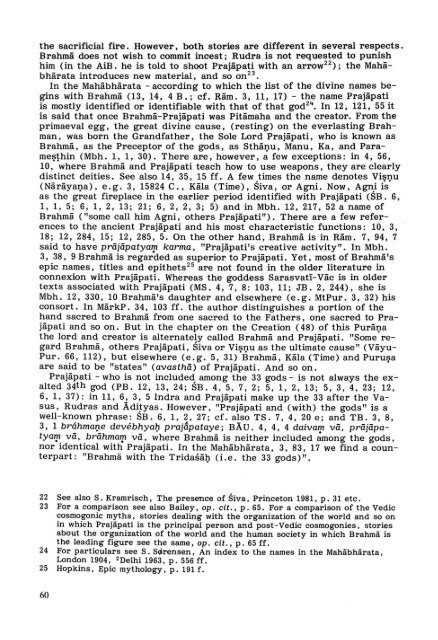Prajapati's relations with Brahman, Brhaspati and Brahma - DWC
Prajapati's relations with Brahman, Brhaspati and Brahma - DWC
Prajapati's relations with Brahman, Brhaspati and Brahma - DWC
Create successful ePaper yourself
Turn your PDF publications into a flip-book with our unique Google optimized e-Paper software.
the sacrificial fire. However, both stories are different in several respects.<br />
Brahmä does not wish to commit incest; Rudra is not requested to punish<br />
him (in the AiB. he is told to snoot Prajäpati <strong>with</strong> an arrow 22 ); the Mahäbhärata<br />
introduces new material , <strong>and</strong> so on 23 •<br />
In the Mahäbhärata - according to which the list of the divine names begins<br />
<strong>with</strong> Brahmä (13, 14, 4 B.; cf. Räm. 3, 11, 17) - the name Prajäpati<br />
is mostly identified or identifiable <strong>with</strong> that of that god 2 4. In 12, 121, 55 it<br />
is said that once Brahmä-Prajäpati was Pitämaha <strong>and</strong> the creator. From the<br />
primaeval egg, the great divine eau se , (resting) on the everlasting <strong><strong>Brahma</strong>n</strong>,<br />
was born the Gr<strong>and</strong>father , the Sole Lord Prajäpati, who is known as<br />
Brahmä, as the Preceptor of the gods, as SthäI).u, Manu, Ka, <strong>and</strong> Parame/?1hin<br />
(Mbh. 1, 1, 30). There are, however, a few exceptions: in 4, 56,<br />
10, where Brahmä <strong>and</strong> Prajäpati teach how to use weapons, they are clearly<br />
distinct deities. See also 14, 35, 15 ff. A few times the name denotes Visnu<br />
(NäräyaI).a), e. g. 3, 15824 C., Käla (Time), Siva, or Agni. Now, Agn} i~'<br />
as the great fireplace in the earlier period identified <strong>with</strong> Prajäpati (SB. 6,<br />
1, 1, 5; 6,1,2, 13; 21; 6,2,2,3; 5) <strong>and</strong> in Mbh. 12,217,52 a name of<br />
<strong>Brahma</strong> ("some caU him Agni, ot hers Prajäpati"). There are a few references<br />
to the ancient Prajäpati <strong>and</strong> his most characteristic functions : 10, 3,<br />
18; 12,284, 15; 12,285,5. On the other h<strong>and</strong>, Brahmä is in Räm. 7,94, 7<br />
said to have prajapatya,!! karma, "Prajäpati's creative activity". In Mbh.<br />
3, 38, 9 Brahmä is regarded as superior to Prajäpati. Yet, most of Brahmä 's<br />
epic names, titles <strong>and</strong> epithets 25 are not found in the older literature in<br />
connexion <strong>with</strong> Prajäpati. Whereas the goddess Sarasvatï-Väc is in older<br />
texts associated <strong>with</strong> Prajäpati (MS. 4, 7, 8: 103, 11; JB. 2, 244), she is<br />
Mbh. 12, 330, 10 Brahmä's daughter <strong>and</strong> elsewhere (e.g. MtPur. 3, 32) his<br />
consort . In MärkP. 34, 103 ff. the author distinguishes a portion of the<br />
h<strong>and</strong> sacred to Brahmä from one sacred to the Fathers , one sacred to Prajäpati<br />
<strong>and</strong> so on. But in the chapter on the Creation (48) of this PuraI).a<br />
the lord <strong>and</strong> creator is alternately caUed Brahmä <strong>and</strong> Prajäpati. "Some regard<br />
Brahmä, ot hers Prajäpati, Siva or Vi/?I).u as the ultimate cause" (Väyu<br />
Pur. 66, 112), but elsewhere (e.g. 5, 31) Brahmä, Käla (Time) <strong>and</strong> Puru/?a<br />
are said to be "states" (avastha) of Prajäpati. And so on.<br />
Prajäpati - who is not included among the 33 gods - is not always the exalted<br />
34th god (PB. 12, 13,24; SB. 4, 5, 7, 2; 5,1,2, 13; 5,3,4,23; 12,<br />
6, 1, 37): in 11, 6, 3, 5 Indra <strong>and</strong> Prajäpati make up the 33 af ter the Vasus,<br />
Rudras <strong>and</strong> Ädi!yas. However, "Prajäpati <strong>and</strong> (<strong>with</strong>) the gods" is a<br />
weU-known phrase: SB. 6, 1, 2, 27; cf. also TS. 7, 4, 20 e; <strong>and</strong> TB. 3, 8,<br />
3, 1 bráhma1)e devébhya1) prajápataye; BÄ U. 4, 4, 4 daiva,!! va, prajapatya,!!<br />
va, brahma,!! va, where <strong>Brahma</strong> is neither included among" the gods,<br />
nor identical <strong>with</strong> Prajäpati. In the Mahäbhärata, 3, 83, 17 we find a counterpart:<br />
"Brahmä <strong>with</strong> the Tridasäl:1 (i. e. the 33 gods)".<br />
22 See also S. Kramrisch, The presence of Siva, Princeton 1981, p. 31 etc.<br />
23 For a comparison see also Bailey, op. eH., p. 65. For a comparison of the Vedic<br />
cosmogonic myths, stories dealing <strong>with</strong> the organization of the world <strong>and</strong> so on<br />
in which Prajäpati is the principal person <strong>and</strong> post-Vedic cosmogonies, stories<br />
about the organization of the world <strong>and</strong> the human society in which Brahmä is<br />
the leading figure see the same, op. eH., p. 65 ff.<br />
24 For particulars see S. S!Srensen, An index to the names in the Mahäbhärata,<br />
London 1904. 2 Delhi 1963, p. 556 ff.<br />
25 Hopkins. Epic mythology, p. 191 f.<br />
60
















